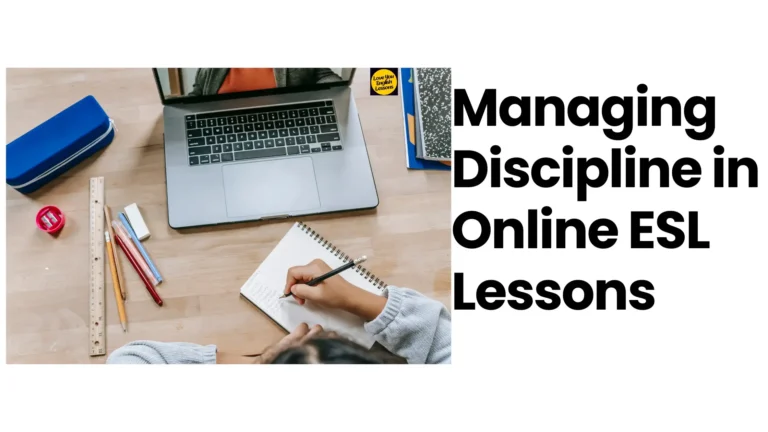Teaching English As a Second Language: A Comprehensive Guide
Lately, there has been a big change in how we learn things.
Regular classrooms used to be super important for learning, but now online classes are becoming just as popular.
Online education is becoming really popular and is giving teachers and students awesome chances to learn in new ways.
In this lesson, we’ll talk about online education and why it’s a great option for people who love teaching.
The Growing Trend of Online Education
The world of education is changing a lot, and online learning is leading the way.
Thanks to fast internet and new technology, it’s easier than ever to get a good education.
Schools and teachers are realizing that online platforms can help them reach students all over the world.
One of the coolest things about online education is how big it is.
Now, anyone can take classes and find resources that match their interests and needs, no matter where they live.
This is great because it means that more people can get an education, even if they couldn’t before because of where they lived or how much it cost. Online learning is also super flexible.
Students can learn at their own pace and fit their studies around their busy lives.
Teachers can also create and teach courses in their own way, without having to worry about physical classrooms.
It’s a whole new way of learning!
You may want to read:
- Effective Strategies for Teaching English Grammar
- How to Teach English to Beginners
- Using Technology to Improve English Teaching
- Get Started Teaching English Abroad: A Step-By-Step Guide
- Certifications for Teaching English
Benefits of Teaching Online
Teaching online is not just great for students, but it also has many advantages for teachers.
Here are some of the reasons why teaching online is so beneficial:
Reaching a Global Audience:
When teachers teach online, they can connect with students from all over the world.
They are not limited to just local or regional students. This means they can share their knowledge with people from every corner of the globe.
Flexibility:
Online teaching offers teachers a lot of flexibility.
They can create their own schedules and work from anywhere as long as they have an internet connection.
This is especially helpful for teachers who have other responsibilities or want a better balance between work and personal life.
Exciting Teaching Tools:
Online platforms provide teachers with a wide range of innovative teaching tools and technologies.
They can use interactive multimedia resources and virtual classrooms to make learning more engaging and immersive for their students.
Cost-Effective:
Teaching online is more cost-effective compared to traditional schools.
There are fewer overhead costs involved, which benefits both teachers and students.
This makes quality education more accessible and affordable for everyone.
Continuous Learning and Growth:
Teaching online requires teachers to stay updated with the latest trends and developments in their field.
This not only benefits their students but also helps teachers grow personally and professionally.
Teaching online opens up a world of opportunities for both teachers and students.
It allows for global connections, flexibility, access to innovative tools, cost-effectiveness, and continuous learning.
Know your audience
It’s super important to know your audience if you want to be successful.
Whether you’re a teacher switching from regular classrooms to virtual ones or a business person trying out e-learning, understanding who you’re teaching is really, really important.
Identifying Your Target Audience
Before you start making your course or online platform, figure out who your audience is.
They’re not just random “students” or “learners”; they’re unique individuals with different needs and reasons for learning.
Demographics:
First, think about the age, gender, location, job, and education of your ideal student.
Knowing these details will help you make content and marketing strategies that work better.
Psychographics:
Look deeper into what your audience likes, believes in, and struggles with.
What makes them want to learn?
Understanding these things will help you make content that really connects with your audience.
Market Research:
Do some research to learn about other online learning groups, competitors, and trends.
Check out forums, social media groups, and online discussions in your field to see what your audience is talking about.
Feedback and Surveys:
Talk directly to your audience to get feedback.
Use surveys, polls, or interviews to find out what they like, what challenges they face, and what they want to learn.
Understanding Their Needs and Preferences
This means going deeper than just basic info like age and getting to the heart of why they want to learn online.
What are their main goals for learning?
Do they want to gain new skills, move up in their jobs, or just explore things they’re interested in?
Knowing what they want will help you create content that meets their needs.
People learn in different ways, so it’s important to think about how your audience likes to learn.
Some people like watching videos or looking at pictures, while others prefer reading or doing interactive activities.
Make sure you mix things up to cater to everyone’s style.
What challenges are your audience dealing with as they learn?
Whether it’s not having enough time, money, or confidence, knowing what they’re up against will help you give them the support they need.
Find out where your audience likes to go online and what kinds of content they enjoy.
Do they spend a lot of time on YouTube, or do they prefer taking courses on sites like Udemy or Coursera?
Make sure you deliver your content in a way that fits their preferences.
Tailoring Your Content to Meet Their Requirements
Now that you know all about your audience – who they are, what they like, and what they need – it’s time to make your content perfect for them.
Here’s how:
Make it relevant:
Your course content should match what your audience wants to learn and achieve.
Don’t give them generic stuff that doesn’t apply to them. Instead, focus on giving them valuable information that they can relate to.
Personalize it:
Everyone learns differently, so try to cater to each individual’s needs and preferences.
Let them choose their own learning path, give them personalized recommendations, and create opportunities for them to give feedback and interact with the material.
Keep them engaged:
Make your content interesting and interactive so that your audience stays focused.
Add quizzes, discussions, case studies, and real-life examples to make the learning experience more fun and engaging.
Keep improving:
Don’t stop at just one version of your content.
Continuously gather feedback from your audience and use it to make your content even better.
Be flexible and adapt to their changing needs and preferences so that your courses always stay relevant and impactful.
Discovering your niche is like finding your special spot in the online classroom.
It doesn’t matter if you’ve been teaching for a while or are new to the game, figuring out the perfect subject and niche for your online teaching journey is super important.
Assessing Your Expertise and Passion
Before you jump into the world of teaching online, take a moment to think about what you’re really good at and what you love.
What subjects or topics are you really great at?
What do you know a lot about and want to share with others?
Your expertise is like the foundation for your online teaching adventure.
It helps you figure out what subjects you’re not only knowledgeable about, but also excited to teach.
Start by making a list of subjects or topics that match up with what you’re good at and what you enjoy.
Think about your education, work experience, and hobbies.
What topics make you super excited?
What do you find yourself naturally drawn to in conversations or discussions?
Figuring out what you’re really good at and passionate about will help you choose the perfect niche for your online teaching.
Researching Market Demand and Trends
Passion and expertise are important, but it’s also crucial to understand what people want and what’s popular.
To do this, you need to do thorough research.
Start by checking out online learning platforms, educational websites, and marketplaces.
Look for subjects and courses that are trending.
See if there are any patterns in the number of students enrolling, the reviews they leave, and the profiles of the instructors.
Keep an eye out for new trends and areas where there’s a lot of demand.
These can be great opportunities for you to find your own special niche.
You can also use keyword research tools and analytics platforms to find out how many people are searching for different topics.
Look for keywords and phrases that are related to what you’re good at and see how popular and relevant they are.
This data-driven approach will give you valuable insights into which subjects are in demand and worth pursuing.
Selecting a Profitable Niche
Once you know what you’re good at and what the market is like, it’s time to pick a niche for your online teaching business.
It’s not just about what you love, but also about making money.
Think about how big the market is, who your competition is, and how you can make money from it.
Find a niche where there’s a good demand but not too many people doing the same thing, so you can become a top expert in that area.
Also, think about whether your niche can grow over time.
Will people keep wanting your courses, or is it just a passing trend?
Think about how you can expand and offer more within your niche to keep making money in the long run.
The best niche is one that combines what you love and are good at with what people want and will pay for.
If you get that right, you’ll do great in the online teaching world!
Create brand
It’s super important to create a strong brand if you want to be successful.
As an online teacher, your brand isn’t just about your logo or website – it’s also about showing you know your stuff, connecting with your students, and building trust.
Establishing Credibility and Authority
One of the first things you need to do as an online educator is to show that you know what you’re talking about.
You want your audience to trust that you’re an expert in the subject you teach.
Here are some ways to do that:
Share what you know:
Write blog posts, make videos, record podcasts, or host webinars about topics that relate to what you teach.
By consistently sharing valuable information, people will see you as an authority in your field.
Show off your qualifications:
Let people know about your degrees, certifications, awards, and work experience on your website and social media profiles.
This will help them see that you have the knowledge and experience to teach them.
Speak up:
Offer to speak at conferences, workshops, or other events in your industry.
This will give you more exposure and show people that you really know your stuff.
Share your research:
If you’ve done any research papers, case studies, or whitepapers in your field, publish them.
This shows that you’re dedicated to staying up-to-date and contributing to the knowledge in your area of expertise.
By following these strategies, you’ll build credibility and authority as an online educator.
Use Social Media and Networking
Social media is a great way to build your brand and connect with people. Here are some tips to make the most of it:
Pick the Right Platforms:
Find out which social media sites your target audience likes the most and focus on those.
For example, if you’re teaching cool things, Instagram and Pinterest might be better than LinkedIn.
Keep Your Brand Consistent:
Make sure your brand looks the same on all your social media profiles. Use the same pictures, cover photos, and info. This helps people recognize you and remember you.
Talk to Your Audience:
Be active and talk to the people who follow you.
Respond to their comments, answer their questions, and join in on discussions.
This makes them feel like they’re part of a community and helps them trust you.
Share Good Stuff:
Post a mix of things on your social media. Share educational stuff, behind-the-scenes looks, success stories, and personal stories.
Try to give something valuable to your audience with every post.
Generating Testimonials and Reviews
Testimonials and reviews are really important because they show that other students trust and like your online courses.
If you want to get testimonials and reviews, here are some things you can do:
Ask for Feedback:
Get in touch with students who have taken your course before and ask them to share their thoughts about it.
You can even offer them discounts or free stuff in return for their testimonials.
Share Success Stories:
Talk about students who have done well or overcome challenges because of your course.
Show how your course has helped them. This can be a great way to convince others to take your course too.
Encourage Reviews:
Tell your students to leave reviews and ratings on websites where your courses are listed, like Udemy or Teachable.
Positive reviews can make more people notice your courses and want to join.
Show Testimonials Clearly:
Put testimonials in a place where people can easily see them on your website and course sales pages.
You can even include pictures and names (if they say it’s okay) to make the testimonials more believable.
Content is king
Good content is really important. Your class materials aren’t just facts; they’re like the foundation of your teaching adventure.
Making interesting content is key to getting students interested and helping them understand what you’re teaching.
Developing High-Quality Course Materials
When it comes to teaching online, the quality of your course materials can determine whether you succeed or fail. Here are some important ways to create high-quality content:
Set Clear Learning Goals:
Before you start creating content, make sure you know what you want your students to learn in each lesson or module.
Having clear goals will help you stay focused and guide your content creation process.
Organize Information Well:
Make sure your course materials are organized in a logical and easy-to-follow way.
Break down complex topics into smaller, manageable parts and use headings, bullet points, and visuals to make it easier for students to understand.
Provide Valuable Content:
Make sure your content adds value to your students’ learning experience.
Include insights, real-life examples, case studies, and practical exercises that reinforce important concepts and help students understand better.
Be Consistent:
Keep a consistent tone, style, and formatting throughout your course materials.
This not only makes it easier for students to read and follow along but also helps establish your identity as a professional educator.
Use Clear and Simple Language:
Avoid using complicated language or jargon that might confuse or alienate your students.
Use simple and straightforward language to effectively communicate your ideas.
Update Regularly:
Keep your course materials up to date with the latest information, research, and trends in your field.
Regular updates show your dedication to providing relevant and timely content to your students.
Use Multimedia Elements Effectively
Multimedia elements like videos, pictures, infographics, and audio can make learning more fun and interesting.
Here are some ways to use them effectively:
Make Videos for Demonstrations and Explanations: Create videos to show how things work, explain processes, or give step-by-step guides.
Videos help people understand better and suit different learning styles.
Add Relevant Pictures and Graphics:
Use images, charts, and infographics to highlight important points and make long texts easier to read.
Visual aids can help people remember information better.
Try Interactive Content: Use quizzes, polls, and interactive activities to involve your students in the learning process.
Interactive content makes learning more engaging and helps students understand the topic better.
Share Audio Resources: Provide audio recordings or podcasts for students who prefer listening to lectures.
Audio resources are great for students who are busy or like to do more than one thing at a time.
Make it Accessible: Make sure everyone can access your multimedia elements, including students with disabilities.
Use alternative text for images, captions for videos, and transcripts for audio to help all students learn better.
Making Your Content Interactive and Engaging
Engagement is really important when teaching online.
Here are some ways to make your lessons more interactive and interesting:
Get students involved:
Include activities, discussions, and group projects in your lessons.
This will help students actively participate and use what they’ve learned in real-life situations.
Encourage students to interact with each other:
Create chances for students to talk to each other through online forums, group activities, or reviewing each other’s work.
This will help them feel like they’re part of a community and give them extra support in their learning.
Give feedback on time:
Make sure to give feedback on students’ progress in a timely and helpful way.
This will keep them motivated and on track. Personalized feedback will also help them know what they need to work on and improve.
Make learning fun:
Add elements of games to your lessons, like badges, leaderboards, and rewards.
This will make learning more enjoyable and engaging. You can also include challenges and activities that make students excited to participate.
Create a sense of connection:
Make sure your students feel supported and included in the online learning environment.
Regularly communicate with them, answer their questions, and encourage meaningful interactions.
This will help them feel valued and connected to the class.
Managing Your Online Teaching Business
Setting Pricing and Payment Options
It’s super important to set the right prices for your online teaching business to make sure it does well.
Think about these things when you’re deciding how much to charge and how people can pay:
Look at the market: Check out what other courses like yours are charging.
Explain what makes your course special and why it’s worth the price.
Give people different ways to pay, like all at once, in parts, or with a subscription.
Offer deals and special prices to get more students interested.
Make sure your prices are clear and there are no hidden fees.
Managing Enrollments and Registrations
It’s super important to have a smooth enrollment and registration process for your students.
Here are some tips to help you manage enrollments effectively:
Make sure the registration process is easy to understand with simple forms and clear instructions.
Use automated systems to make enrolling quicker and to give students access to course materials right away.
Send confirmation emails with all the important info about the course.
Keep track of waitlists and course capacities so everyone can join without any problems.
And don’t forget to have clear policies for cancellations, withdrawals, and refunds to avoid any confusion.
As an online teacher, being able to adjust to what’s popular, listen to feedback, and expand your business can really impact your journey to creating a successful online teaching business.
Adapting and Growing
The world of online education is always changing, with new technologies, teaching methods, and market needs influencing how we teach and learn.
To stay competitive, it’s important to keep up with industry trends.
Here’s how:
Keep Learning:
Just like you tell your students to keep learning, you need to do the same.
Stay informed about the latest research, innovations, and best practices in online education by attending conferences, webinars, and professional development events.
Connect with Others:
Surround yourself with other educators, experts, and leaders in the field.
Join online communities, forums, and social media groups focused on online teaching.
Share ideas, experiences, and learn from each other’s successes and mistakes.
Research the Market:
Regularly research the market to spot new trends, niche opportunities, and changing consumer preferences.
Study what your competitors are doing, keep an eye on industry news, and use data analytics tools to understand market trends.
Collecting and Analyzing Feedback
Getting feedback is super important for online teaching businesses.
It helps you see how well your courses are working, how happy your students are, and where you can make things better.
You can do this by using surveys and questionnaires to ask your students about the course content, how you teach, and their overall experience.
Make sure to use online tools to collect and analyze the feedback.
Also, create feedback loops in your courses to keep the communication going.
Encourage students to give feedback after each module, assignment, or assessment.
After collecting feedback, take the time to look for patterns and trends in the data.
This will help you see what you’re doing well and what you can improve on. Use this info to make your teaching even better!
Scaling Your Online Teaching Business
Offer More Variety:
Think about creating different types of courses to attract a wider range of students.
You could also explore new topics or areas of interest, or even offer special classes like advanced lessons or personal coaching sessions.
Make Things Easier:
Find ways to make your work more efficient by using technology.
You can use tools and software to automate tasks that you do over and over again, like sending out messages or grading assignments.
You can also get help from other people, like hiring freelancers to create content or assist with marketing.
Build a Strong Foundation:
Make sure your online teaching platform is ready to handle more students and activities.
Invest in good hosting services and learning management systems that can handle lots of users without slowing down.
It’s also important to have reliable technology partners who can help you as your business grows.
Final thoughts
To sum up, starting to teach online is not just about sharing what you know—it’s about always growing, adapting, and coming up with new ideas.
By keeping up with what’s happening in the field, listening to feedback, and planning your business wisely, you can set yourself up for success in the ever-changing world of online education.
Recap of Key Points
It’s super important to keep up with what’s happening in the online education world so that you can stay in the game and be competitive.
Getting feedback from students and looking at it closely can help you make your courses even better and keep your students happy.
If you want to grow your online teaching business, you need to offer different things, make things automatic, and set up a strong foundation for future growth.
If you’re still unsure about starting your online teaching journey, I want to give you some encouragement.
Online education is full of exciting opportunities for teachers like you to make a real impact, reach students all over the world, and earn a good income.
Don’t let fear or doubt hold you back—take the leap and discover the endless possibilities waiting for you in the digital world of online teaching.
Next Steps
As you begin your online teaching adventure, remember that success is not a destination but a continuous journey of growth and learning.
Stay curious, be flexible, and always strive to provide value to your students.
Embrace challenges as chances to improve, and never stop working on your skills as an educator.
With dedication, perseverance, and a willingness to adapt, there’s no limit to what you can achieve in your online teaching business.
Good luck on your exciting journey and may your love for teaching inspire students all over the world to learn and grow!
________________________






